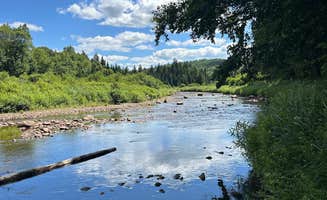Dispersed camping opportunities around Stony Creek, New York, provide rustic outdoor experiences within the Adirondack Forest Preserve. The region features multiple primitive sites scattered across elevations ranging from 1,100 to 3,100 feet, creating diverse camping environments from riverside locations to mountain ponds. Winter temperatures regularly drop below freezing, while summer averages 75-80°F with frequent afternoon thunderstorms.
What to do
Hiking and fishing access: Bear Slide in Lake George Wild Forest offers remote camping with nearby hiking trails. A camper reports, "It was rocky getting there but super super remote - zero service. Great space for my jeep and honestly you could fit a LARGE RV."
Wildlife viewing: Visit the serene waterways near Fort Plain Lock 15 where campers regularly spot local wildlife. "The parking lot is large, rocky, and uneven, situated right on the Mohawk River. It's a great spot for wildlife viewing and fishing with a valid license," notes one visitor.
Swimming and cliff jumping: Several sites feature natural swimming areas, particularly during summer months when water temperatures rise. Some lakeside locations offer stone ledges for swimming access with deeper water for jumping.
What campers like
Secluded locations: Cod Pond Dispersed Pull-Off provides privacy despite road proximity. A camper shares: "Decent site right off of the 'main' road. 'Main' because it was quiet. Easy to access via a short dirt road, but also easy to miss...Felt private despite the road."
Water access: Many campsites feature streams or ponds within walking distance. According to one camper at Cod Pond, "There was a fire ring and access to the river down a semi-steep bank. Beautiful to listen to at night."
Natural surroundings: Primitive camping near Stony Creek offers undeveloped settings with minimal human impact. The region maintains strict environmental protection regulations, preserving the natural landscape and minimizing overcrowding at camping sites.
What you should know
Road conditions: High-clearance vehicles are recommended for many access roads in the area. At Crane Pond Dispersed Site, a camper advises: "From experience - if your vehicle isn't lifted you may come out with a ding or two from rocks and other things jutting out of the ground. Not fit for an RV in any capacity."
Communication limitations: Plan ahead as communication is limited throughout the area. Multiple sites report no cellular coverage, requiring advanced preparation for emergencies.
Seasonal considerations: Spring camping often brings muddy conditions on access roads and trails. Summer weekends can see increased visitors, particularly at waterfront sites. Fall offers cooler temperatures but requires preparation for sudden weather changes.
Tips for camping with families
Site selection: Choose locations with natural features that engage children. Crane Mountain Pond Campsite receives praise for its scenic setting: "After a short hike up steep crane mountain we watched the beautiful sun set. One of the nicest places I've camped at."
Water safety: Riverside and pond-adjacent sites require supervision for children. Sites with gradual water entry are preferable for families with younger children.
Pack extras: The remote nature of these sites means bringing additional supplies. Plan for temperature fluctuations, as mountain elevations can bring cooler evenings even in summer months.
Tips from RVers
Size limitations: Most dispersed sites near Stony Creek accommodate smaller rigs only. Ushers Road State Forest offers primitive camping options accessible by smaller vehicles. A visitor notes, "This trailhead provides access to bicycle-friendly nature trails. About 500 feet down the right-hand trail, there is a smaller path branching off to the left. This leads to a previously used campsite."
Level parking: Finding level ground for larger vehicles can be challenging. Many sites feature uneven terrain requiring stabilizers or creative parking solutions.
Resource management: Without hookups, water conservation and waste management become essential. Plan for at least 2 gallons of water per person daily, with additional capacity for cooking and cleaning needs.



